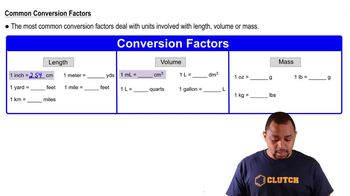Here are the essential concepts you must grasp in order to answer the question correctly.
Molarity
Molarity is a measure of concentration defined as the number of moles of solute per liter of solution. It is expressed in units of moles per liter (mol/L). To calculate molarity, one must know the amount of solute in grams, convert it to moles using the molar mass, and then divide by the volume of the solution in liters.
Recommended video:
Molar Mass
Molar mass is the mass of one mole of a substance, typically expressed in grams per mole (g/mol). For sodium chloride (NaCl), the molar mass is calculated by adding the atomic masses of sodium (Na) and chlorine (Cl). This value is essential for converting grams of solute into moles, which is a necessary step in determining molarity.
Recommended video:
Volume Conversion
Volume conversion is the process of changing the volume measurement from one unit to another, such as from milliliters (mL) to liters (L). Since molarity is defined in terms of liters, it is crucial to convert the volume of the solution to liters by dividing the volume in milliliters by 1000. This ensures that the molarity calculation is accurate.
Recommended video:
Common Conversion Factors
 Verified step by step guidance
Verified step by step guidance


